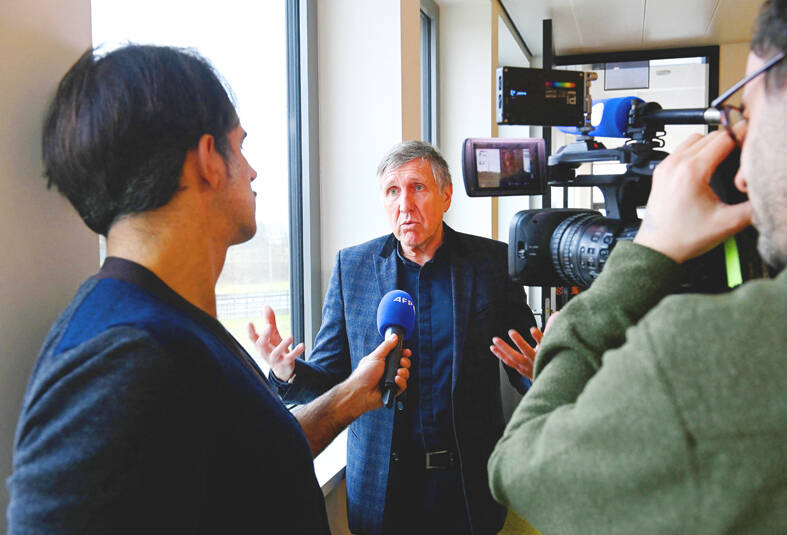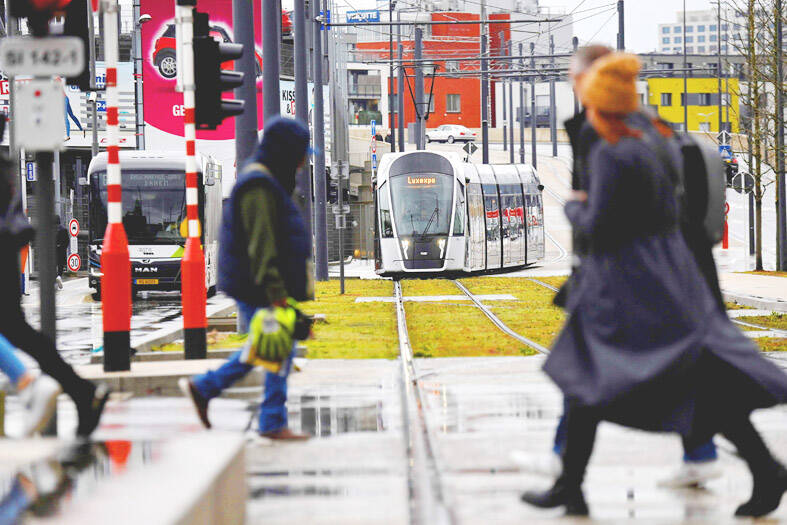Three years after Luxembourg declared all public transport free in a bid to clear its roads of jams and cut pollution, the car is still king of the congested grand duchy.
Traffic permitting, it is barely an hour’s drive from Weiswampach in the far north of Luxembourg near the German and Belgian borders to Dudelange in the south, next door to France.
The wealthy country of just 650,000 people appeared the perfect place for a bold experiment — making public transport on trains, trams and buses free nationwide.

Photo: AFP
However, Luxembourg, despite its lack of long-distance highways, has one of the highest rates of vehicle ownership in Europe, with only Poland exceeding its rate of 681 vehicles per 1,000 residents.
Cross-border workers bring in tens of thousands more vehicles every day as commuters head to jobs in Luxembourg, and long-distance drivers often pass by to fill their tanks in a country with low fuel taxes.
“I often say that Germans build cars and Luxembourgers buy them,” joked Luxembourgian Deputy Prime Minister Francois Bausch, who is in charge of mobility and public works.

Photo: AFP
Three years after ticket offices closed, there is no sign that Luxembourg has ditched vehicles for the tram, even if Bausch sees a thinning of traffic in the capital.
“Car culture is truly dominant and it remains pretty tricky to attract motorists onboard public transport,” said Merlin Gillard, a mobility expert at the Luxembourg Institute of Socio-Economic Research.
Luxembourg, along with the rest of the EU, is attempting to transform itself into a carbon neutral economy by adopting green technologies in transport, energy, factories and farms.
Luxembourgian Prime Minister Xavier Bettel’s coalition government invests 800 million euros (US$863 million) a year on public transportation.
The duchy has Europe’s highest-funded tram network per capita, costing 500 euros per person each year.
“It is the country that invests the most in Europe, but Luxembourg is coming from far behind,” Gillard said. “We’re making up for investment that has been very weak for years.”
In Luxembourg City, a modern financial services center built around an historic old town nestling in tight loops of the Alzette River, passengers appreciate the changes.
The central station is undergoing a thorough renovation, an ultra-modern funicular links the upper town to the riverside, and road lanes have been set aside for buses and trams.
Most of all, though, and uniquely in Europe: The network is free.
Edgar Bisenius, owner of a financial services business, said this is the prime consideration when choosing between a vehicle and the bus.
“It’s very positive for the environment,” he said.
French-language teacher Ben Dratwicki travels around the capital by bicycle on personal business, but takes the funicular and the train to get to his school 20km north of the city.
“Transport is a basic right for residents,” he said. “If we have the right to work, we should also have the right to be taken to work, without paying over the odds.”
However, Dratwicki seems to be in a minority across the country, where traffic jams of private vehicles still block major arteries during rush hour.
Part of the explanation might be the 220,000 cross-border workers, vital to Luxembourg’s economy, who arrive every day from neighboring countries to earn higher wages.
The trains and buses they could board in France, Belgium or Germany are not free until they cross into Luxembourg, and many daily workers remain wedded to their vehicles.
Bausch, of the Green Party, has a plan to help some of the French workers, who after all pay their income taxes in Luxembourg.
He aims to finance car parks on the French side of the border, and has promised that from 2027 or 2028 there would be a train from the French town of Thionville to Luxembourg every seven minutes.
However, experts like Gillard are skeptical, saying the problem is embedded in the underlying structure of Luxembourg’s economy.
French workers cannot afford rents or property in Luxembourg, but much of the cash they save by living at home is wasted on the busy and polluting commute to work, Gillard said.

Taiwan Semiconductor Manufacturing Co (TSMC, 台積電) yesterday said that its investment plan in Arizona is going according to schedule, following a local media report claiming that the company is planning to break ground on its third wafer fab in the US in June. In a statement, TSMC said it does not comment on market speculation, but that its investments in Arizona are proceeding well. TSMC is investing more than US$65 billion in Arizona to build three advanced wafer fabs. The first one has started production using the 4-nanometer (nm) process, while the second one would start mass production using the

A TAIWAN DEAL: TSMC is in early talks to fully operate Intel’s US semiconductor factories in a deal first raised by Trump officials, but Intel’s interest is uncertain Broadcom Inc has had informal talks with its advisers about making a bid for Intel Corp’s chip-design and marketing business, the Wall Street Journal reported, citing people familiar with the matter. Nothing has been submitted to Intel and Broadcom could decide not to pursue a deal, according to the Journal. Bloomberg News earlier reported that Taiwan Semiconductor Manufacturing Co (TSMC, 台積電) is in early talks for a controlling stake in Intel’s factories at the request of officials at US President Donald Trump’s administration, as the president looks to boost US manufacturing and maintain the country’s leadership in critical technologies. Trump officials raised the

‘SILVER LINING’: Although the news caused TSMC to fall on the local market, an analyst said that as tariffs are not set to go into effect until April, there is still time for negotiations US President Donald Trump on Tuesday said that he would likely impose tariffs on semiconductor, automobile and pharmaceutical imports of about 25 percent, with an announcement coming as soon as April 2 in a move that would represent a dramatic widening of the US leader’s trade war. “I probably will tell you that on April 2, but it’ll be in the neighborhood of 25 percent,” Trump told reporters at his Mar-a-Lago club when asked about his plan for auto tariffs. Asked about similar levies on pharmaceutical drugs and semiconductors, the president said that “it’ll be 25 percent and higher, and it’ll

CHIP BOOM: Revenue for the semiconductor industry is set to reach US$1 trillion by 2032, opening up opportunities for the chip pacakging and testing company, it said ASE Technology Holding Co (日月光投控), the world’s largest provider of outsourced semiconductor assembly and test (OSAT) services, yesterday launched a new advanced manufacturing facility in Penang, Malaysia, aiming to meet growing demand for emerging technologies such as generative artificial intelligence (AI) applications. The US$300 million facility is a critical step in expanding ASE’s global footprint, offering an alternative for customers from the US, Europe, Japan, South Korea and China to assemble and test chips outside of Taiwan amid efforts to diversify supply chains. The plant, the company’s fifth in Malaysia, is part of a strategic expansion plan that would more than triple